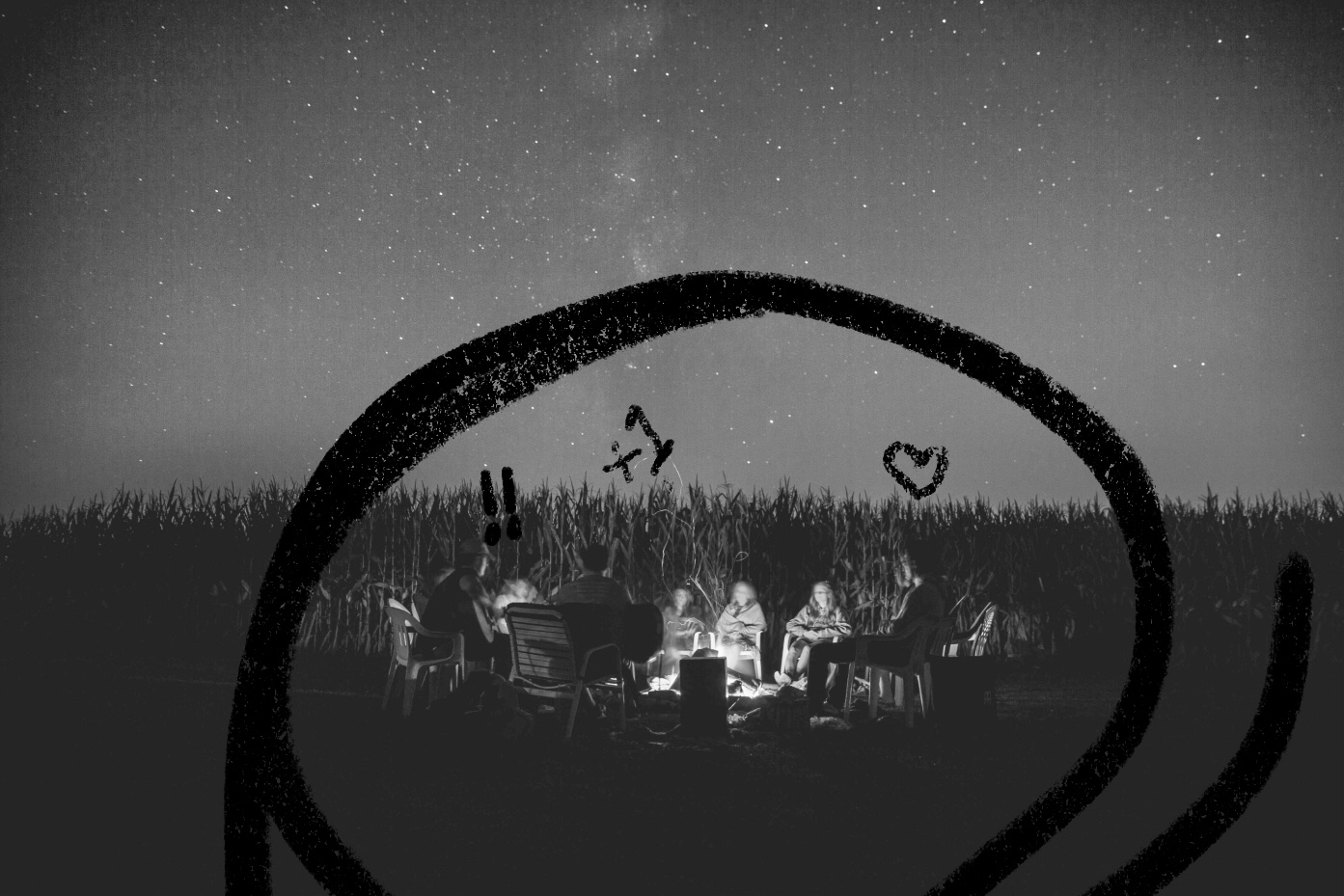
Hi, Nathan here! It’s been too long, I know!! I’ve got a big piece on product wedges coming out next week, but today I am so excited to share with you this special guest post from one of my favorite writers on the internet: Ali Montag.
I love Ali’s writing because it focuses me on the things that actually matter. It takes me to a calm, centered place, where I can see my goals with new clarity. Upon first read, this post may seem more like writing advice than business strategy, but upon closer inspection you will see this lesson is critical for anyone building anything.
You’re gonna love this one.
—Nathan
On Wednesday nights in Austin, I meet with a group of friends in a nearby backyard. We’re a bit of a weird bunch, different ages and different hometowns. It’s not clear anymore how we know each other. It’s hot in Texas, but we still end up around a firepit.
We’re there to talk about writing. There are cold beers, cheeseburgers, and a short lesson about a writer or an idea. I usually disagree with something and stir up a tussle. We jot notes, but we don’t publish much of what we write. The fire offers a tangible reminder of what we’re doing: creating white pages with black ink that will either outlive us or burn up into smoke.
I leave with a buoyant feeling, ready to work. There’s nothing so beautiful as the written word. I can do it: I can put on a pot of coffee and produce something.
At home, I sit at my desk, wobbly and missing a screw, and prepare to begin. I open the Google Doc. The cursor blinks back at me, once, twice, three times. I’ll start in a minute, I think. Let the coffee kick in. Before I know it, my Twitter feed is open and scrolling, words flying past my eyes.
Other writers are succeeding, Twitter tells me. Other writers are amassing hundreds of thousands of followers, earning a legitimacy that will help them pitch book deals and land magazine covers. Other writers are turning their work into businesses. He did it. And he did it. And she did it too. And him. And him. And HER! Other writers aren’t wasting time. They’re not eating cheeseburgers. They’re publishing, publishing, publishing. They’re pitching editors and tweeting quips and churning out blog posts. Other writers are playing the game.
Staring at my screen, tinkering with a silly little paragraph I’ve written and rewritten for six months, I’m consumed by doubt: What am I doing?
In 1944, C.S. Lewis gave a lecture to the students of King’s College at the University of London. He asked the students to consider what he called the “Inner Ring.” He described it like this: In any group, there is an ever-shifting circle of “insiders.” Who is on top? Who is well liked? Who has the smartest ideas? Who holds sway?
Inevitably, he said, we compare ourselves (outsiders) to members of the Inner Ring (insiders.) We want to be inside the ring. Anyone who has eaten in a high school cafeteria knows the feeling: “Everything would be so much better if I were just sitting over there.” An Inner Ring exists in every office, university, church, and bingo hall.
Part of Lewis’s definition of the Inner Ring was its subtlety. It’s never explicitly clear who is inside. This keeps everyone on their toes; the rules are always changing. The top dog yesterday might be an outcast tomorrow.
In 2021, we can watch the Inner Ring of creative work shift and transform in real time, right in the palms of our hands. Who went viral today? Who had the best Substack post? Who landed a book deal?
Those of us watching (outsiders) are driven to emulate those succeeding (insiders.) We can touch their success with our fingertips. We’re drawn to chase after it: How can we do what they’re doing? The only way to get into the digital Inner Ring is to try. Throw open the doors: Show the world what you’re working on. Publish that draft. Send that tweet. Launch that newsletter. Let everyone in to have a look around, then change and iterate your work with their feedback. Let popularity be your guide.
Across the industry, the incentives of creative work are changing. Long confined to the halls of Ivy League universities, Hollywood agencies, and Manhattan publishing houses, creative work is now available to anyone with a laptop and WiFi. The gatekeepers have been disrupted. Attention, rather than clout or connections, is what matters now.
With frictionless distribution, creative people are no longer incentivized to please art critics or book reviewers. They aren’t incentivized to toil for a decade in isolation, tossing manuscripts into the wastebin, ripping through paragraphs with red ink. They are incentivized to create—as much as possible. Film a YouTube video every week. Photograph an Instagram post every day. Write constantly on Substack, publish and iterate at a fast clip. Why edit? The more you post, the more likely it is that the algorithms will shift in your favor, eyeballs collecting like fireflies in your digital net.
It’s advantageous to share your work—and your every thought—with as wide an audience as possible. You don’t need to hone the perfect manuscript. Just put stuff out there. Increase your surface area. Build in public. Audiences will tell you what they want, and then you can create more of it.
I read this advice on Twitter, and it follows me long after I close my laptop. I climb into the shower and the doubt comes with me, unable to be washed away. Should I spend more time building an audience? Publishing data is abysmal: 98% of books sell less than 5,000 copies. Why write something if no one buys it? The reality is, you have to fight for your own readers.
But with an audience comes scrutiny, and with scrutiny comes insecurity. David Perell, a man with 209,000 Twitter followers, put it this way: “Every sentence is scrutinized until soon, we get stuck in a prison of fear and risk-aversion.” Building in public means thinking in public, and thinking in public means exposing all of your quirks and questions to the smoothing waves of likes and clicks.
How could you ever write anything interesting with 209,000 people watching?
The upside, the hopeful promise of the new creative era, is one of meritocracy: It doesn’t matter where you went to school. It doesn’t matter who your dad was, or wasn’t. It only matters if you’re good.
But that brings up a troublesome question: When it comes to creative work, what is good?
On TikTok, Instagram, YouTube, Facebook, and Substack, free markets offer an answer for those of us keeping score. Whose work is good? Well, whoever’s work makes the most money. Check any economics textbook: Price is the best indicator of value. “Charli D’Amelio is making a lot of money. She must be good.” Amazon spent $8.4 billion for “high quality storytelling.” Those movies must be good. Strong writing isn’t just a hobby at places like Andreesseen Horowitz and Coinbase, it’s core to their business. Today’s smartest MFA students will be paid six figure salaries to “craft narratives.” Will that work be good?
Good means lucrative. Good means popular.
The result of this thinking—pervasive across the Internet economy—is a dreary one: “This system culminates in the muddled median of everyone on earth’s most average tastes,” writes Vox’s Rebecca Jennings: “What we’re seeing is the lowest common denominator of what human beings want to look at, appealing to our most base impulses... The result is, well, mediocre.”
From Business Insider reporter Kat Tenbarge: “Mediocrity sells.”
The algorithmic flattening of creative work isn’t just happening on TikTok. It’s happening anywhere creatives are incentivized to prioritize popularity over ingenuity, writes John Logan, a screenwriter for the James Bond films (which are now held within Amazon’s catalog.)
“From my experience, here’s what happens to movies when [commercial] concerns start invading the creative process: Everything gets watered down to the most anodyne and easily consumable version of itself. The movie becomes an inoffensive shadow of a thing, not the thing itself. There are no more rough edges or flights of cinematic madness. The fire and passion are gradually drained away as original ideas and voices are subsumed by commercial concerns, corporate oversight and polling data.”
This is the price of chasing the Inner Ring. The desire to be likeable—to win entrance into the upper echelons of the attention marketplace, to be noteworthy and taken note of, to make a hit movie or write a best-selling book—provokes the same reaction from anyone who harbors it: inescapable mediocrity.
If you want to be in the Inner Ring, you’ve already lost.
The incentives driving creative work matter. It’s just as important why you create something as it is what you create. A story written only for profit, attention, or fame won’t be much of a story at all.
“The aim of art [is] to ask the big questions,” writes the author George Saunders. “How are we supposed to be living down here? What were we put here to accomplish? What should we value? What is truth, anyway, and how might we recognize it?”
The work of a writer is to take those questions seriously. To take your work seriously. To take the chemical reaction happening in the hearts and minds of your readers seriously. Again, from George, “That’s what an artist does: takes responsibility.”
So what should we do? C.S. Lewis, as always, knew the answer to the question before he asked it. “The quest of the Inner Ring will break your hearts unless you break it,” he explained. “But if you break it, a surprising result will follow. If in your working hours you make the work your end, you will presently find yourself all unawares inside the only circle in your profession that really matters. You will be one of the sound craftsmen, and other sound craftsmen will know it.”
Just work. That’s it. Focus on what stirs you up inside, what is beautiful and true. Work on making something good—not something that is liked. Take responsibility. The work will lead you home.
Sitting around that campfire in Austin, studying the pages of writers I admire with friends and neighbors I admire, none celebrities and none trying to be, I knew: I’d already made it into the only circle that matters.
Ali Montag is a writer that lives in Austin, Texas. Her work has previously appeared in CNBC, Austin Chronicle, NBC, Miami Herald, and McClatchy DC—and her newsletter is amazing.You can follow Ali on Twitter: @ali_montag
Find Out What
Comes Next in Tech.
Start your free trial.
New ideas to help you build the future—in your inbox, every day. Trusted by over 75,000 readers.
SubscribeAlready have an account? Sign in
What's included?
-
Unlimited access to our daily essays by Dan Shipper, Evan Armstrong, and a roster of the best tech writers on the internet
-
Full access to an archive of hundreds of in-depth articles
-
-
Priority access and subscriber-only discounts to courses, events, and more
-
Ad-free experience
-
Access to our Discord community

Comments
Don't have an account? Sign up!